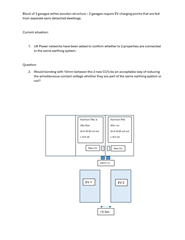Scenario
A remote block of 3 garages, 2 will be fed from separate properties via 40m of 10mm EV SWA connected to 2 individual new CU's
( no cars will be parked inside the garages but charged on the drive in front of the garage door)
1 property is TNC-S - Ze 0.30 Ohms and the other is visually a TNS but with Ze 0.32 Ohms and similar L-N reading.
The 2 chargers will have Pen fault protection and the relevant RCD protection as usual.
There are underground services within 1 -10m of a potential TT rod so could be problematic and a maximum 2.5m between separate garage earth rods is possible.
The concern is simultaneous contact between the 2 vehicles.
Regulation 411.3.1.1 states that “simultaneously accessible conductive parts shall be connected to the same earthing system individually, in groups or collectively.”
I am currently waiting for UK Power networks to confirm the 2 properties are connected to the same earthing system.
The questions are:
Is Pen fault and RCD protection enough when connecting both cars to TNS/TNCS or is there anything else we can do?
Is separate TT earth rods along with simultaneous risk assessment the safest option in this case?
Thank you
I've attached a sketch of the current proposal to help explain. PDF
PDF
